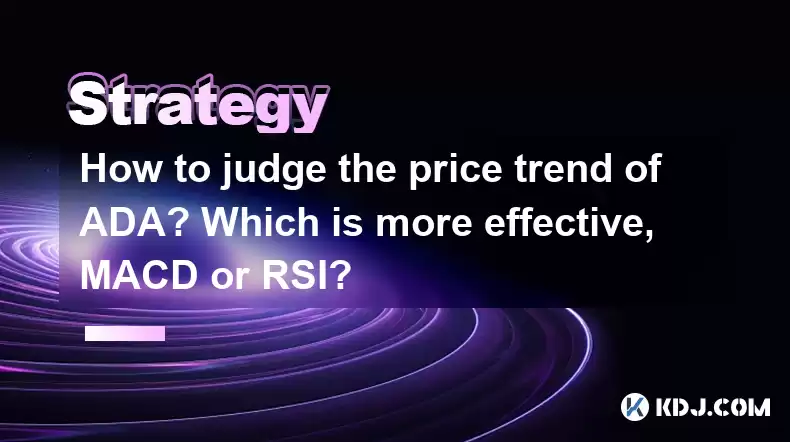-
 bitcoin
bitcoin $108842.957301 USD
-1.88% -
 ethereum
ethereum $3931.777121 USD
-1.66% -
 tether
tether $1.000186 USD
-0.03% -
 bnb
bnb $1153.250882 USD
-2.20% -
 xrp
xrp $2.367904 USD
-1.94% -
 solana
solana $186.182050 USD
-4.20% -
 usd-coin
usd-coin $0.999997 USD
0.00% -
 tron
tron $0.316949 USD
-1.00% -
 dogecoin
dogecoin $0.190780 USD
-3.12% -
 cardano
cardano $0.651324 USD
-2.67% -
 hyperliquid
hyperliquid $37.141055 USD
-0.85% -
 ethena-usde
ethena-usde $0.999224 USD
-0.09% -
 chainlink
chainlink $17.579031 USD
-2.47% -
 bitcoin-cash
bitcoin-cash $509.426284 USD
-2.79% -
 stellar
stellar $0.315298 USD
-2.93%
How to judge the price trend of ADA? Which is more effective, MACD or RSI?
To judge ADA's price trend, use fundamental analysis for underlying factors and technical analysis with MACD for trends and RSI for overbought/oversold conditions.
Apr 28, 2025 at 10:14 pm

Understanding how to judge the price trend of Cardano (ADA) is crucial for traders and investors looking to make informed decisions. ADA, like other cryptocurrencies, experiences price fluctuations influenced by various factors such as market sentiment, technological developments, and broader economic conditions. In this article, we will explore how to assess the price trend of ADA and compare two popular technical indicators, MACD and RSI, to determine which might be more effective for analyzing ADA's price movements.
Understanding ADA's Price Trend
To judge the price trend of ADA, it's important to consider both fundamental and technical analysis. Fundamental analysis involves evaluating the underlying factors that could affect ADA's value, such as Cardano's technological advancements, partnerships, and overall market conditions. On the other hand, technical analysis focuses on historical price data and chart patterns to predict future price movements.
Fundamental Analysis of ADA
When conducting fundamental analysis on ADA, you should focus on several key areas:
- Technological Developments: Cardano's development team regularly updates the platform with new features and improvements. Keeping an eye on these updates can provide insights into the project's progress and potential impact on ADA's price.
- Partnerships and Adoption: Cardano's partnerships with other companies and its adoption by various institutions can significantly influence its value. Positive news in this area often leads to increased demand for ADA.
- Market Sentiment: The overall sentiment in the cryptocurrency market can affect ADA's price. Positive sentiment can drive prices up, while negative sentiment can lead to declines.
Technical Analysis of ADA
Technical analysis is a more data-driven approach to predicting ADA's price trend. It involves analyzing price charts and using various indicators to identify patterns and trends. Two commonly used indicators are the Moving Average Convergence Divergence (MACD) and the Relative Strength Index (RSI).
MACD: How It Works
The MACD is a trend-following momentum indicator that shows the relationship between two moving averages of a cryptocurrency's price. It consists of the MACD line, the signal line, and the histogram. Here’s how to use MACD to analyze ADA's price trend:
- MACD Line: This is the difference between the 12-period and 26-period exponential moving averages (EMA).
- Signal Line: A 9-period EMA of the MACD line.
- Histogram: The difference between the MACD line and the signal line.
To use MACD for ADA:
- Bullish Signal: When the MACD line crosses above the signal line, it indicates a potential upward trend. If the histogram bars are increasing in height, it further confirms the bullish momentum.
- Bearish Signal: When the MACD line crosses below the signal line, it suggests a potential downward trend. Decreasing histogram bars indicate bearish momentum.
RSI: How It Works
The RSI is a momentum oscillator that measures the speed and change of price movements. It ranges from 0 to 100 and is typically used to identify overbought or oversold conditions. Here’s how to use RSI to analyze ADA's price trend:
- Overbought: An RSI value above 70 indicates that ADA may be overbought, suggesting a potential price correction.
- Oversold: An RSI value below 30 indicates that ADA may be oversold, suggesting a potential price rebound.
To use RSI for ADA:
- Divergence: Look for divergences between the RSI and ADA's price. If the price is making new highs but the RSI is not, it could signal a weakening trend.
- Failure Swings: RSI failure swings above 70 or below 30 can indicate potential trend reversals.
Comparing MACD and RSI for ADA
Both MACD and RSI are valuable tools for analyzing ADA's price trend, but they serve different purposes and can be used in conjunction for a more comprehensive analysis.
- MACD is particularly useful for identifying trend changes and momentum. It can help traders determine when to enter or exit a position based on the crossing of the MACD and signal lines.
- RSI is more focused on identifying overbought and oversold conditions, which can help traders anticipate potential price reversals.
Which Indicator is More Effective for ADA?
Determining which indicator is more effective for analyzing ADA's price trend depends on your trading strategy and goals. Here are some considerations:
- Trend Following: If you are a trend follower, MACD might be more effective as it provides clear signals for trend changes and momentum shifts.
- Mean Reversion: If you are looking to capitalize on price reversals, RSI could be more useful as it helps identify overbought and oversold conditions.
- Combining Indicators: Using both MACD and RSI together can provide a more robust analysis. For example, a bullish MACD crossover combined with an RSI moving out of oversold territory could be a strong buy signal.
Practical Application: Using MACD and RSI for ADA
To apply MACD and RSI to analyze ADA's price trend, follow these steps:
- Choose a Trading Platform: Select a platform that offers charting tools with MACD and RSI indicators, such as Binance, Coinbase Pro, or TradingView.
- Set Up the Chart: Open an ADA/USD chart and add both the MACD and RSI indicators.
- Analyze MACD:
- Look for crossovers between the MACD line and the signal line.
- Monitor the histogram for increasing or decreasing bars.
- Analyze RSI:
- Check if the RSI is above 70 (overbought) or below 30 (oversold).
- Look for divergences between the RSI and ADA's price.
- Combine Insights: Use the signals from both indicators to make informed trading decisions. For example, a bullish MACD crossover combined with an RSI moving out of oversold territory could be a strong buy signal.
Frequently Asked Questions
Q: Can fundamental analysis alone predict ADA's price trend accurately?A: While fundamental analysis provides valuable insights into ADA's potential value, it is not sufficient on its own to predict price trends accurately. Combining fundamental analysis with technical analysis, such as using MACD and RSI, can provide a more comprehensive view of ADA's price movements.
Q: How often should I check the MACD and RSI indicators for ADA?A: The frequency of checking MACD and RSI depends on your trading style. For short-term traders, checking these indicators multiple times a day may be necessary. For long-term investors, weekly or even monthly checks might be sufficient.
Q: Are there other technical indicators that can be used in conjunction with MACD and RSI for ADA?A: Yes, other technical indicators that can complement MACD and RSI include the Moving Average (MA), Bollinger Bands, and the Stochastic Oscillator. Each of these indicators provides different insights and can help confirm or challenge the signals provided by MACD and RSI.
Q: How can I avoid false signals when using MACD and RSI for ADA?A: To avoid false signals, consider the following strategies:
- Use multiple timeframes to confirm signals. A signal on a daily chart is more reliable if it is also present on a weekly chart.
- Combine MACD and RSI with other indicators to increase the probability of accurate signals.
- Be aware of market news and events that could cause sudden price movements, which might lead to false signals.
Disclaimer:info@kdj.com
The information provided is not trading advice. kdj.com does not assume any responsibility for any investments made based on the information provided in this article. Cryptocurrencies are highly volatile and it is highly recommended that you invest with caution after thorough research!
If you believe that the content used on this website infringes your copyright, please contact us immediately (info@kdj.com) and we will delete it promptly.
- Dogecoin's Wild Ride: Market Turmoil and Price Decline Explained
- 2025-10-17 18:25:12
- Newsmax, Crypto, and the Frontier of Corporate Finance: A New Yorker's Take
- 2025-10-17 18:45:16
- XRP Price, 2030 Prediction, Crypto Presale: Decoding the Future
- 2025-10-17 18:25:12
- Paxos' PYUSD "Oops!" Moment: 300 Trillion Tokens and Crypto's Wild Ride
- 2025-10-17 18:45:16
- Trump, Crypto, and Political Power: A New Coin and a Market Correction
- 2025-10-17 18:50:12
- Bubblemaps, ChainOpera, and COAI Profits: A Deep Dive into the BNB Ecosystem
- 2025-10-17 18:30:13
Related knowledge

Practical parameter settings for a Bitcoin multi-timeframe moving average system
Sep 18,2025 at 10:54pm
Optimizing Timeframe Combinations for Bitcoin Trading1. Selecting appropriate timeframes is crucial when building a multi-timeframe moving average sys...

How can I filter out false breakouts in Dogecoin high-frequency trading?
Sep 22,2025 at 01:00am
Understanding False Breakouts in Dogecoin Trading1. A false breakout occurs when Dogecoin's price appears to move beyond a defined support or resistan...

Techniques for identifying tops and bottoms in the Bitcoin on-chain NVT model
Sep 20,2025 at 07:54pm
Understanding the NVT Model in Bitcoin Analysis1. The Network Value to Transactions (NVT) ratio is often described as the 'P/E ratio' of the cryptocur...

What does the surge in open interest in Bitcoincoin futures mean?
Sep 20,2025 at 11:18pm
Understanding the Surge in Dogecoin Futures Open Interest1. A surge in open interest within Dogecoin futures indicates a growing number of active cont...

How can I use the Ethereum USDT premium to gauge market sentiment?
Sep 18,2025 at 11:55pm
Understanding the Ethereum USDT Premium1. The Ethereum USDT premium refers to the price difference between USDT (Tether) traded on Ethereum-based plat...

What should I do if Ethereum staking yields decline?
Sep 20,2025 at 06:18am
Understanding the Causes Behind Declining Ethereum Staking Yields1. The Ethereum network transitioned to a proof-of-stake consensus mechanism with the...

Practical parameter settings for a Bitcoin multi-timeframe moving average system
Sep 18,2025 at 10:54pm
Optimizing Timeframe Combinations for Bitcoin Trading1. Selecting appropriate timeframes is crucial when building a multi-timeframe moving average sys...

How can I filter out false breakouts in Dogecoin high-frequency trading?
Sep 22,2025 at 01:00am
Understanding False Breakouts in Dogecoin Trading1. A false breakout occurs when Dogecoin's price appears to move beyond a defined support or resistan...

Techniques for identifying tops and bottoms in the Bitcoin on-chain NVT model
Sep 20,2025 at 07:54pm
Understanding the NVT Model in Bitcoin Analysis1. The Network Value to Transactions (NVT) ratio is often described as the 'P/E ratio' of the cryptocur...

What does the surge in open interest in Bitcoincoin futures mean?
Sep 20,2025 at 11:18pm
Understanding the Surge in Dogecoin Futures Open Interest1. A surge in open interest within Dogecoin futures indicates a growing number of active cont...

How can I use the Ethereum USDT premium to gauge market sentiment?
Sep 18,2025 at 11:55pm
Understanding the Ethereum USDT Premium1. The Ethereum USDT premium refers to the price difference between USDT (Tether) traded on Ethereum-based plat...

What should I do if Ethereum staking yields decline?
Sep 20,2025 at 06:18am
Understanding the Causes Behind Declining Ethereum Staking Yields1. The Ethereum network transitioned to a proof-of-stake consensus mechanism with the...
See all articles










































































